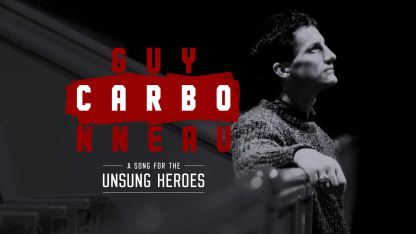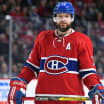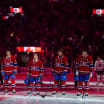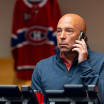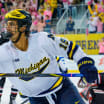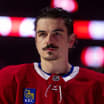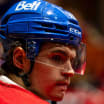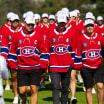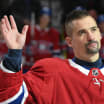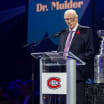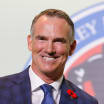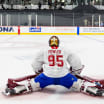Guy Carbonneau's NHL draft day was not one typically befitting a future Hall-of-Famer.
After all, most Hall of Fame-caliber players have a pretty good idea they'll be getting picked on the big day. And yet on August 9, 1979, Carbonneau, a 19-year-old scoring phenom for the Quebec Major Junior Hockey League (QMJHL)'s Chicoutimi Sagueneens, did not expect to have his name called by one of the NHL's 21 teams at the Queen Elizabeth Hotel in Montreal.
The 1979 Entry Draft was a turning point for the League's annual selection affair. Known up until then as the Amateur Draft, the event was the first to take place with the four teams from the defunct World Hockey Association - the Edmonton Oilers, Hartford Whalers, Quebec Nordiques, and Winnipeg Jets - now in the NHL's fold. To coincide with the merger, the NHL expanded Draft eligibility requirements, which resulted in a deeper pool of prospects from which to choose.
Perhaps because of that flood of talent, or because the circumstances surrounding the Draft were different in those days, the Sept-Iles native - who had put up 62 goals and 141 points in 72 games for Chicoutimi that season - only got the slightest inkling he might get drafted when Canadiens scout Eric Taylor called him that morning.
"Today, players go to the arena for the Draft. In my day, we didn't make trips just for that. I had gotten some phone calls from teams to test the waters, and I got a call from Montreal," remembered Carbonneau.
"But it was only the day of the Draft… I was in Chicoutimi then and they came to find me on the golf course to tell me I had just been picked by the Canadiens."
In 1979-80, Carbonneau returned to Chicoutimi for his fourth and final year of Junior and tore it up, finishing second in the league with 182 points (72G, 110A) before turning pro and producing at an above point-per-game clip with the Canadiens' AHL affiliate at the time, the Nova Scotia Voyageurs.
But despite his offensive pedigree and knack for lighting the lamp, the story of Carbonneau's journey to the Hockey Hall of Fame is not one of goals, assists, and scoring titles. Rather, it's a tale of his adaptability, intelligence, and some of the greatest defensive prowess of his time.
Switching on the Selke
These days, Carbonneau's work as a defensive specialist is legendary in Montreal. But his career as a serial Selke trophy winner only really started taking root after Jacques Lemaire took the coaching reins for the Canadiens in 1983-84, Carbonneau's second full year in the NHL.
It was Lemaire - who scored 20 or more goals in each of his 12 seasons in Montreal and won eight Stanley Cups as a player - who encouraged Carbonneau to hone the defensive side of his game and become the proficient two-way player he was. And given that the sophomore forward was hungry for action, Carbonneau was quick to soak up his advice.
"I was a young guy coming up with the Canadiens, who had just won four Stanley Cups; my ice time wasn't huge. Jacques Lemaire came at a good time. He was a player who was able to put up points offensively but also play well defensively and he was looking for a player like that," recounted Carbonneau. "He probably saw in my game that I was able to do it. We talked about it a few times and he wanted to play me against the other teams' top lines. To do that, I had to give up some of my offensive game and I worked on defense a lot more. That allowed me to play 18, 20, 22 minutes a game instead of the three or four I had been getting in the past."
Carbonneau didn't neglect the offensive side of his game, however. He still managed to score 20 or more goals each season from 1983-84 to 1985-86, notching 54, 57, and 56 points, respectively, in that span.
During the 1986 Stanley Cup run, Carbonneau contributed a healthy 12 points (7G, 5A) - including the game-winner in Game 2 of the Division finals against the Hartford Whalers - ranking him fifth in team scoring behind the likes of Mats Naslund, Claude Lemieux, Bobby Smith, and Larry Robinson.
Meanwhile, his plus-9 differential in 20 postseason games was tops on Montreal's championship roster, all the while playing through a knee injury that was being disguised as a groin problem. In the papers, journalists were already calling the five-year veteran the "defensive Gretzky", and in the stands, the crowds chanted "Guy! Guy! Guy!" to show their love for his game.
By that summer, with a Stanley Cup ring in his jewelry box and the name "Gretzky" being used to describe him, Carbonneau's legacy was starting to form.
In June 1988, Carbonneau claimed his first Selke trophy, awarded annually to the League's best defensive forward.
The following season, in addition to leading the team with 10 game-winning goals, Carbonneau earned another Selke nod. That made him only the second player to secure the honor in consecutive seasons since his friend, mentor, and teammate Bob Gainey won the last of his four straight Selkes in 1981.
Of course, the five-time Stanley Cup winner played a huge part in molding Carbonneau into an outstanding two-way player.
"The Frank Selke Trophy was created to celebrate players like Bob. Players like him weren't watched as closely. People paid more attention to guys like Guy Lafleur and Steve Shutt, players who scored goals. The work that Bob did was less publicized, but was just as important," praised Carbonneau. "To have the chance to start my career with Bob [was important in my development]. To travel together, to talk to each other often, to see how he reacted to things. He was the captain, so all those things were huge. Not just on the ice, but off it too."
In 1991-92, Carbonneau won his third Selke Trophy. It marked the sixth time in seven years he had been nominated for the honor.
As an offensive-minded player himself, Kirk Muller - who joined the Canadiens just prior to that season - understood how Carbonneau's flair for scoring in Junior helped contribute to his success at the other end of the ice.
"A lot of offensive guys have the ability to understand how defensive players work," said Muller, who scored 104 goals and collected 247 points over four seasons in Montreal. "If you really want to commit to it, look at players in the game who are two-way players: they're really good offensively, but they have the ability, over the years, to be good defensive players too, if they put their mind to it. Carbo, being such an offensive guy in Junior, understood that to shut players down, you have to take away their strengths. Carbo was a student of the game that way. He embraced that. Every player he had to play against and check had different assets and he had to find a way to shut those guys down. He had the ability to do that over a long period of time, and to do that, you have to be a smart player. You prepare yourself game in and game out to be good consistently and you have to be competitive. That pretty much categorizes the strength of Carbo."
1993: Cementing a legacy
A decorated performer with a Stanley Cup and three Selke Trophies already lining his resume prior to the 1992-93 season, Carbonneau earned a promotion to legendary status that spring through his contributions to the Canadiens' 24th championship, enshrining him as one of the franchise's all-time greats.
Of the Habs' NHL-record 10 overtime wins in the 1993 playoffs, Carbonneau scored the deciding goal in two of them: in Game 2 of the Division finals against the Buffalo Sabres, and in Game 3 of the Conference finals against the New York Islanders.
But once the Stanley Cup Finals against the Los Angeles Kings began, Captain Carbonneau realized he had a different calling: be the "defensive Gretzky" to the Kings' actual Gretzky. After the "Great One" figured on all four goals (1G, 3A) in a 4-1 Los Angeles win in Game 1, Carbonneau asked Jacques Demers for the responsibility of shutting down Gretzky, and the Habs head coach agreed.
With Carbonneau on his tail, "offensive Gretzky" was limited to a one-goal, three-point output over the next four games.
Forward Vincent Damphousse, who led the Habs in scoring that spring with 23 points (11G, 12A) in 20 playoff games, asserts that Carbonneau's defensive contributions that year had an incredible impact. It also demonstrated his courage in the face of some serious adversity.
"When we won in '93, he wasn't at his best; he was hurt most of the year. He had ice bags on his knees and he was suffering, but he kept playing and he kept doing his best to help the team," recalled Damphousse of Carbonneau, who had only played 61 regular season games that season. "To us, his biggest contribution came in the Final when he faced Gretzky starting in the second game. That really helped us focus on what we had to do offensively. Carbo was taking care of Gretzky. He didn't really produce after his first game where he had four points. That made a difference. That made Carbo really focus on what he did best and let us focus on trying to beat the other guys, and it worked for us."
Muller agrees that in '93, the best offense really was great defense.
"If you look at it, Johnny [LeClair] scored the two game-winners in LA and I got the game-winner in the final game. So our line ended up opening up and scoring and creating the offensive side of it," recounted Muller, who was second in team scoring with 17 points (10G, 7A) in those playoffs. "A really big part of that was because the matchup switched, and he did a good job on Wayne and it gave us more freedom to play offense. It was a great switch. We don't score those goals and we don't get that success and everything if Carbo isn't capable of doing the job against one of the greatest of all-time. That right there was a perfect example of how our team was able to have success that year in the playoffs. That was the advantage we had in guys like Carbo."
Carbonneau wasn't just shadowing Gretzky, either; he was putting his body on the line in the name of his team. And his fellow Habs certainly took note.
"What I remember most about Carbo is really his ability to block shots, how he would put his knee down and really block them. He really paid the price so many times, but that's what he was; he was a warrior and he didn't care about getting hurt. It was all about blocking shots and making sure he was in the lane all the time," added Damphousse, who shared the team lead for game winners in those playoffs with three, alongside Muller and LeClair. "I remember so many times where he would either lay down quickly sliding, or he would just put his knee down and block it either with his skate, or his knee, or his arm. He would come back limping to the bench and he would do it again. That's just the type of player he was."
Stats don't speak for Carbo
It was only in 1997-98, Carbonneau's third-to-last season in the League, now with the Dallas Stars, that the NHL started compiling statistics on ice time, faceoffs, blocked shots, and other defensive categories. Until then, the only quantifiable way to measure a forward's defensive worth aside from plus/minus differential was by the number of Selke Trophies a player had on his mantel.
That didn't mean, however, that Carbonneau's two-way talents weren't appreciated at the time by opponents, teammates, and fans.
"He was recognized, because if you were a good player back then you didn't want to face Carbo. If you talk to [Peter] Stastny, or if you talked to Gretzky when we won the Cup in '93, he'd be the first one to recognize Carbo's contributions," affirmed Damphousse. "That's the best proof you can get, talking to ex-players who played against him and who had to face him when he was at his best."
As a teammate, Muller couldn't think of a player he'd played with whose hockey IQ was higher than Carbonneau's.
"He was a smart, defensive hockey player with good skill, but he loved the challenge of shutting players down and being a tough player to play against, and he did that," explained Muller, who assumed the captaincy after Carbonneau was traded to the St. Louis Blues ahead of the 1994-95 campaign. "I played with a lot of good hockey players, a lot of skilled players, but for understanding the game and positioning, I always said that Carbo was probably the smartest hockey player I played with."
Rob Ramage, who was taken first overall that same day in August 1979 and was a member of the 1993 championship team, vividly remembers the acknowledgment Carbonneau would receive from fans for putting his body in harm's way.
"He was the only guy I can remember who got a standing ovation for blocking shots. It was pretty cool. I'd never seen anything like that," shared Ramage, who currently serves as the Canadiens' director of player development. "I'm really happy for him. Those guys need that type of recognition. We can't all have the scorers and the elite talented guys; it takes a lot of guys to win those Cups."
Despite the accolades afforded to Carbonneau, defensive specialists remain unsung heroes in many ways, relegated to a sort of niche appreciation society that doesn't often reach the corridors of the hallowed Hockey Hall of Fame.
All along, however, Carbonneau seemed to have a sense of purpose and the foresight to understand that what he brought to the table did indeed mean a great deal to the game.
"A guy who scores 50 goals a season doesn't need recognition; his stats speak for themselves. It's different for defensive players like Bob Gainey, Steve Kasper, and others," he told La Presse after winning his first Selke in 1988. "Only with time will they get their due."
For Guy Carbonneau, the time has come.

